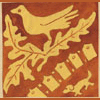
The Collections:
• Parker-Hore

|
TileWeb: Paving-tile Watercolours Online |
The Collections: |
| The Parker-Hore Archive Collection of Watercolours of Paving-tiles | ||
| held in Worcester and in the Ashmolean Museum, Oxford |
|
|
The Study of architectural ceramics |
|
||
|
Innovation, Communication and Interaction Technological and artistic innovations are spread in various ways and at different speeds, specific factors often function as accelerators and others as suppressors, so some ideas spread rapidly while others are apparently shunned.
When decorated floor tiles were introduced to this country, the initial iconography was not English. However, these designs were rapidly assimilated and copied by the emerging new craftworker, the tiler.
The designs in the Parker-Hore Collection have been grouped broadly according to subject. Six categories were adopted:-
Inscriptions - this group includes alphabet tiles and initials A hierarchy was adopted in recording these designs as many of the tiles have composite motifs. 1 Heraldry, 2 Inscriptions, 3 Human figures, 4 Animal or bird or fish designs, 5 Geometric and architectural and finally fleur-de-lys, quatrefoils, rosettes, roses and knots. |
||||
|
Top left: A motif derived from metalwork |
||||
| to ... Decoration | Back to the Study of Architectual Ceramics | to ... Heraldry | ||
| TileWeb Home Page | ||||
|
© Copyright of this digital resource will be held jointly by last updated: jcm/7-jun-2004 |
 |
 |